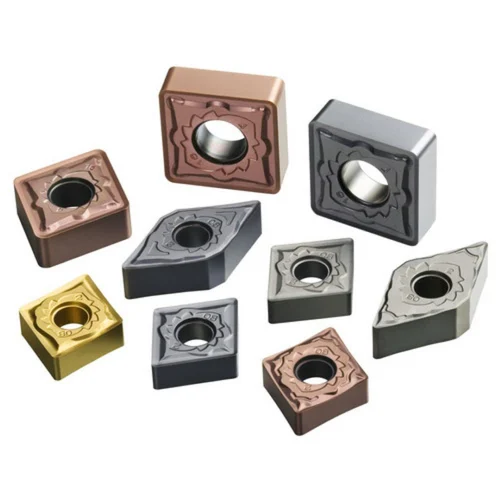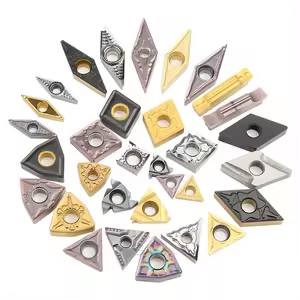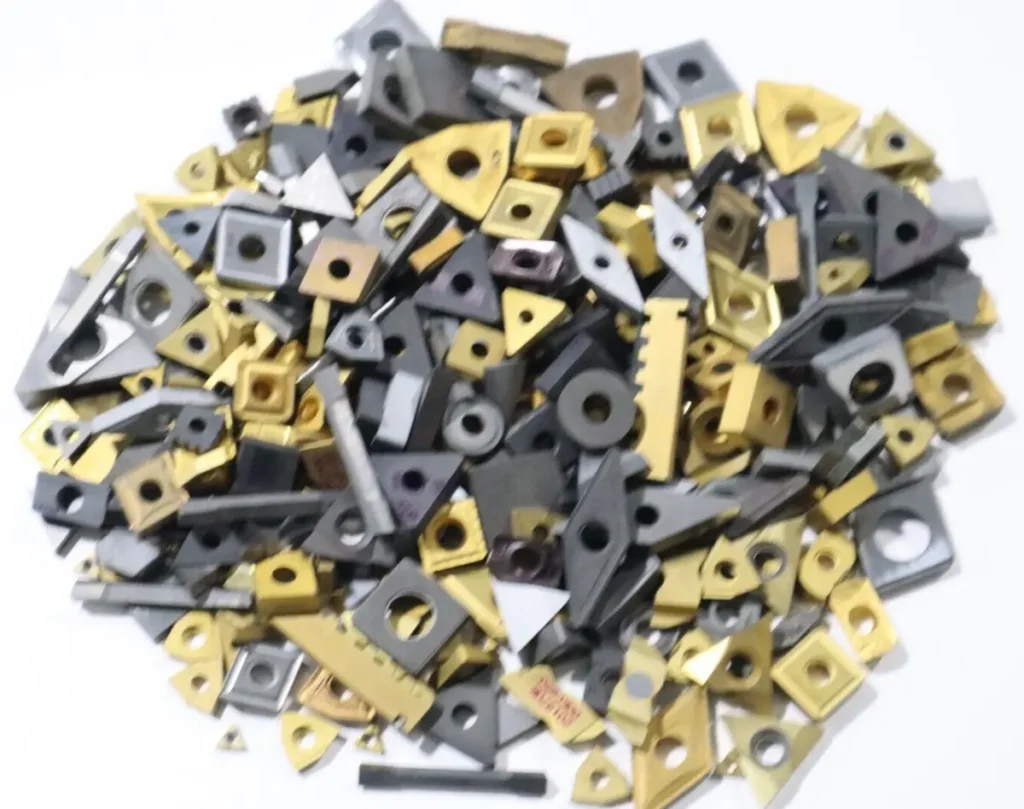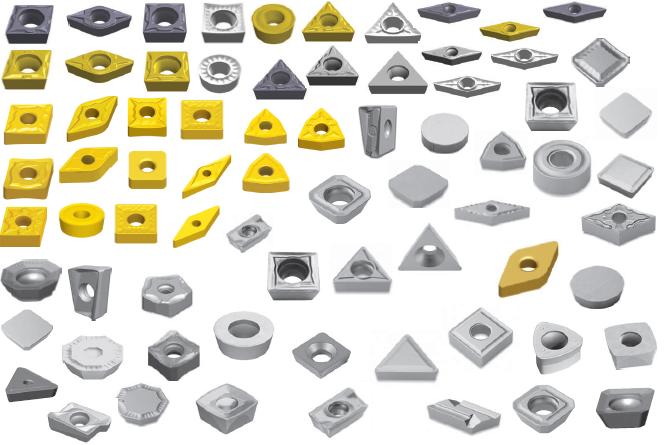Plaquettes d'outils en carbure sont des éléments cruciaux dans les processus modernes d'usinage et de traitement des métaux. Elles offrent des performances de coupe supérieures, une longévité et une polyvalence qui les rendent indispensables dans diverses applications industrielles. Dans ce guide complet, nous examinerons tout ce que vous devez savoir sur les plaquettes en carbure, y compris leurs types, leurs applications, les propriétés des matériaux et la manière de sélectionner la plaquette la mieux adaptée à vos besoins.
Aperçu des plaquettes d'outils en carbure
Les plaquettes d'outils en carbure sont des pointes remplaçables utilisées dans l'usinage pour couper, façonner et finir les matériaux. Elles sont fabriquées en carbure, un matériau composite composé de particules de carbure de tungstène liées à un métal, généralement du cobalt. Cette combinaison confère aux plaquettes en carbure leur dureté et leur durabilité reconnues. Elles sont utilisées dans les opérations de tournage, de fraisage et de perçage dans diverses industries, de l'automobile à l'aérospatiale.

Types de Plaquettes d'outils en carbure
Les plaquettes en carbure se présentent sous de nombreuses formes, tailles et compositions, chacune étant adaptée à des tâches et des matériaux spécifiques. Voici un tableau présentant les différents types de plaquettes en carbure :
| Type d'insertion | Forme | Applications typiques |
|---|---|---|
| CNMG | Diamant | Tournage général, surfaçage et finition |
| TNMG | Triangle | Coupe moyenne à forte, usage général |
| SNMG | Carré | Dégrossissage, coupes interrompues, applications lourdes |
| VNMG | En forme de V | Finition, profilage et applications de haute précision |
| WNMG | Hexagone | Dégrossissage moyen à lourd et coupes interrompues |
| CCMT | Diamant | Coupe légère à moyenne, haute précision et finition |
| DCMT | Diamant | Finition et coupe légère |
| SCMT | Carré | Pour le dégrossissage, les coupes interrompues et les applications lourdes. |
| RCMT | Rond | Tournage léger à moyen, profilage et coupe à grande vitesse |
| APKT | Rectangulaire | Opérations de fraisage, vitesses d'avance élevées et applications lourdes |
Applications des plaquettes en carbure
La polyvalence des plaquettes en carbure leur permet de s'adapter à un large éventail d'applications. Voici un tableau présentant les applications des plaquettes en carbure :
| L'industrie | Application |
|---|---|
| Automobile | Composants de moteur, pièces de transmission, systèmes de suspension |
| Aérospatiale | Aubes de turbines, trains d'atterrissage, composants structurels |
| Médical | Instruments chirurgicaux, implants, prothèses |
| Pétrole et gaz | Trépans, tubages, outils de fond de puits |
| Fabrication | Usinage général, fabrication d'outils et de matrices, fabrication de moules |
| Électronique | Micro-usinage, fabrication de circuits imprimés, dispositifs à semi-conducteurs |
Propriétés des matériaux des plaquettes en carbure
Il est essentiel de comprendre les propriétés des matériaux des plaquettes en carbure pour choisir celle qui convient le mieux à votre application. Voici un tableau présentant les propriétés des matériaux :
| Propriété | Description |
|---|---|
| Dureté | Haute résistance à l'usure et à la déformation, généralement mesurée en Rockwell ou Vickers |
| Solidité | Capacité à absorber l'énergie et à résister à l'écaillage ou à la fracturation |
| Résistance à la chaleur | Conserve sa dureté et sa résistance à des températures élevées |
| Stabilité chimique | Résistant à la corrosion et aux réactions chimiques avec les matériaux de travail |
| Conductivité thermique | Dissipe efficacement la chaleur générée lors de la coupe |






Composition et caractéristiques des Plaquettes d'outils en carbure
Les plaquettes d'outils en carbure sont fabriquées à partir de différentes qualités de carbure, chacune offrant des caractéristiques uniques. Voici un tableau présentant la composition, les propriétés, les caractéristiques, etc :
| Grade | Composition | Caractéristiques |
|---|---|---|
| C1 | 97% WC, 3% Co | Haute résistance à l'usure, utilisée pour les matériaux non ferreux |
| C2 | 94% WC, 6% Co | Polyvalent, convient aux matériaux ferreux et non ferreux |
| C3 | 90% WC, 10% Co | Ténacité plus élevée, utilisée pour les coupes interrompues |
| C4 | 86% WC, 14% Co | Très résistant, convient aux applications lourdes |
| C5 | 81% WC, 19% Co | Très grande robustesse, utilisée pour les applications très lourdes |
| P10 | 92% WC, 8% Co, additifs TiC/TaC | Bon pour la finition à grande vitesse de l'acier |
| P20 | 89% WC, 11% Co, additifs TiC/TaC | Tournage et fraisage d'acier à usage général |
| P30 | 85% WC, 15% Co, additifs TiC/TaC | Ebauche et coupes interrompues dans l'acier |
| K10 | 94% WC, 6% Co, Cr3C2/TaC additifs | Finition et semi-finition de la fonte |
| K20 | 90% WC, 10% Co, Cr3C2/TaC additifs | Ebauche de la fonte et des métaux non ferreux |
Dureté, solidité et résistance à l'usure
Voici un tableau indiquant la dureté, la solidité et la résistance à l'usure des plaquettes en carbure :
| Grade | Dureté (HV) | Ténacité (MPa) | Résistance à l'usure |
|---|---|---|---|
| C1 | 1800 | 1200 | Très élevé |
| C2 | 1600 | 1500 | Haut |
| C3 | 1500 | 1800 | Moyen |
| C4 | 1400 | 2200 | Moyen |
| C5 | 1300 | 2500 | Faible |
| P10 | 1700 | 1400 | Haut |
| P20 | 1600 | 1600 | Moyen |
| P30 | 1500 | 2000 | Faible |
| K10 | 1650 | 1300 | Haut |
| K20 | 1500 | 1800 | Moyen |
Spécifications, tailles, formes, normes
Les plaquettes en carbure sont disponibles dans différentes spécifications, tailles et formes. Voici un tableau indiquant les spécifications, les tailles, les formes et les normes :
| Forme | Taille (mm) | Épaisseur (mm) | Norme ISO | Norme ANSI |
|---|---|---|---|---|
| Triangle | 12, 16, 20 | 3.97, 4.76, 6.35 | ISO 1832 | ANSI B212.4 |
| Diamant | 11, 13, 16 | 2.38, 3.18, 4.76 | ISO 1832 | ANSI B212.4 |
| Carré | 12, 16, 20 | 3.97, 4.76, 6.35 | ISO 1832 | ANSI B212.4 |
| Rond | 16, 20, 25 | 4.76, 6.35, 9.53 | ISO 1832 | ANSI B212.4 |
| Rectangulaire | 10, 15, 20 | 2.38, 3.97, 4.76 | ISO 1832 | ANSI B212.4 |
Fournisseurs et détails des prix
Le choix du bon fournisseur est crucial pour garantir la qualité et la performance des plaquettes en carbure. Voici un tableau des fournisseurs et de leurs tarifs :
| Fournisseur | Localisation | Fourchette de prix (USD) | Contact |
|---|---|---|---|
| Kennametal | ÉTATS-UNIS | 10-50 par encart | www.kennametal.com |
| Sandvik Coromant | Suède | 15-60 par encart | www.sandvik.coromant.com |
| Iscar | Israël | 12-55 par encart | www.iscar.com |
| Outils Seco | Suède | 13-58 par encart | www.secotools.com |
| Mitsubishi | Japon | 14-60 par encart | www.mitsubishicarbide.com |
| Kyocera | Japon | 10-45 par encart | www.kyocera.com |
| Sumitomo | Japon | 11-50 par encart | www.sumitomotool.com |
| Outils Walter | Allemagne | 13-55 par encart | www.walter-tools.com |
| Tungaloy | Japon | 12-54 par encart | www.tungaloy.com |
| Ceratizit | Luxembourg | 15-60 par encart | www.ceratizit.com |
Comment choisir le bon Plaquettes d'outils en carbure
Pour choisir la bonne plaquette en carbure, il faut tenir compte de plusieurs facteurs, notamment la matière à usiner, le type d'opération d'usinage et les exigences spécifiques de la tâche. Voici un tableau qui montre comment sélectionner les bonnes plaquettes en carbure :
| Facteur | Considérations |
|---|---|
| Matériau à usiner | Dureté, ténacité et abrasivité du matériau |
| Type d'opération | Tournage, fraisage, perçage, finition, ébauche |
| Vitesse de coupe | Les vitesses plus élevées nécessitent des plaquettes ayant une meilleure résistance à la chaleur |
| Vitesse d'alimentation | Des vitesses d'avance plus élevées peuvent nécessiter des plaquettes plus résistantes |
| Profondeur de coupe | Les coupes plus profondes peuvent nécessiter des plaquettes plus résistantes. |
| Capacité des machines-outils | Puissance, rigidité et vitesse de la machine-outil |
| Finition de surface requise | Les opérations de finition peuvent nécessiter des plaquettes avec une structure de grain plus fine. |
| Durée de vie des outils | La durée de vie plus longue de l'outil peut justifier un coût initial plus élevé |
Comparaison des avantages et des limites de Plaquettes d'outils en carbure
Voici un tableau comparant les avantages et les limites des plaquettes en carbure :
| Avantages | Limites |
|---|---|
| Dureté élevée | Peut être fragile, susceptible de s'écailler |
| Excellente résistance à l'usure | Coût plus élevé que celui de l'acier rapide (HSS) |
| Capacité à rester à la pointe de la technologie | Ténacité limitée par rapport aux céramiques |
| Vitesses de coupe élevées | Nécessité d'une manipulation et d'une configuration précises |
| Polyvalence des applications | Inserts spécialisés nécessaires pour des tâches spécifiques |

FAQ
À quoi servent les plaquettes en carbure ?
Les plaquettes en carbure sont utilisées pour couper, façonner et finir divers matériaux lors d'opérations d'usinage telles que le tournage, le fraisage et le perçage.
Pourquoi les plaquettes en carbure sont-elles préférées aux outils en acier rapide ?
Les plaquettes en carbure sont préférées parce qu'elles offrent une dureté supérieure, une résistance à l'usure et la capacité de maintenir les performances de coupe à des vitesses et des températures plus élevées par rapport aux outils en acier rapide (HSS).
Comment choisir la plaquette en carbure adaptée à mon application ?
Pour sélectionner la plaquette en carbure appropriée, il faut tenir compte du matériau usiné, du type d'opération d'usinage, de la vitesse de coupe, de la vitesse d'avance et de l'état de surface requis. Consultez le tableau de sélection ci-dessus pour obtenir des conseils détaillés.
Quelles sont les différentes qualités de plaquettes en carbure ?
Les plaquettes en carbure existent en différentes qualités, chacune étant adaptée à des applications spécifiques. Par exemple, la nuance C1 est très résistante à l'usure pour les matériaux non ferreux, tandis que la nuance P20 est une nuance polyvalente pour le tournage et le fraisage de l'acier.
Les plaquettes en carbure peuvent-elles être réaffûtées ?
Dans la plupart des cas, les plaquettes en carbure ne sont pas réaffûtées. Elles sont plutôt remplacées lorsqu'elles sont usées ou endommagées, car le réaffûtage peut compromettre leur précision et leurs performances.
Quelle est la durée de vie des plaquettes en carbure ?
La durée de vie des plaquettes en carbure dépend de facteurs tels que le matériau usiné, les conditions de coupe et le type d'opération. Une sélection et une utilisation appropriées peuvent maximiser leur longévité.
Quels sont les avantages de l'utilisation de plaquettes en carbure revêtues ?
Les plaquettes en carbure revêtues offrent des avantages supplémentaires, notamment une résistance accrue à l'usure, une réduction du frottement et une durée de vie prolongée de l'outil, en particulier dans les applications à grande vitesse et à haute température.
Où puis-je acheter des plaquettes en carbure ?
Les plaquettes en carbure peuvent être achetées auprès de divers fournisseurs tels que Kennametal, Sandvik Coromant, Iscar, Seco Tools et bien d'autres. Reportez-vous au tableau des fournisseurs pour plus de détails.
Existe-t-il différentes formes de plaquettes en carbure ?
Oui, les plaquettes en carbure se présentent sous différentes formes : triangle, diamant, carré, rond et rectangulaire, chacune étant adaptée à des tâches et applications de coupe spécifiques.
Quelle est la fourchette de prix des plaquettes en carbure ?
Le coût des plaquettes en carbure varie en fonction du fournisseur, de la qualité et du type spécifique. Les prix varient généralement de $10 à $60 par plaquette. Pour plus d'informations, reportez-vous au tableau des prix des fournisseurs.
En conclusion, les plaquettes en carbure sont essentielles pour des opérations d'usinage efficaces et précises. En comprenant leurs types, leurs applications, leurs propriétés et la manière de sélectionner la bonne plaquette, vous pouvez optimiser vos processus d'usinage et obtenir des résultats supérieurs.




